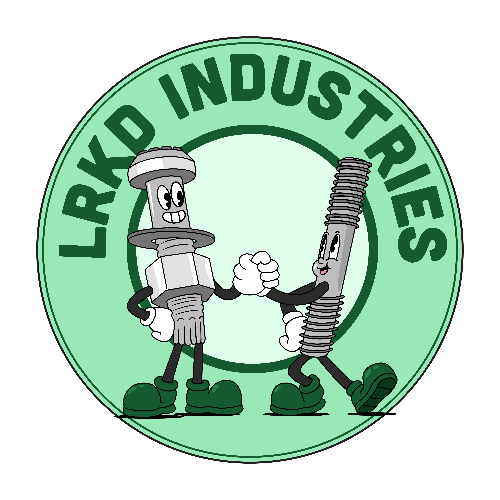Why Do Anchor Bolts Matter? Imagine you’re standing at the base of a towering skyscraper. It’s awe-inspiring, isn’t it? But have you ever thought about what keeps structures like that securely tethered to the ground? Enter the unsung heroes of heavy-duty construction: anchor bolts. These robust, often-overlooked components are the bedrock (pun intended) of stability and safety in many projects.
When it comes to Anchor Bolts, not all are created equal. Two grades under ASTM F1554—Grades 55 and 105—are particularly vital for demanding applications. But what sets them apart? Let’s break it down and uncover why they’re essential for heavy-duty projects.
Anchor Bolts 101: What Are They?
Anchor bolts are long, threaded fasteners designed to connect structural and non-structural elements to concrete. Picture them as the sturdy glue between steel beams and concrete foundations. They’re used in a wide array of projects, from bridges and buildings to industrial equipment installation.
Their significance cannot be overstated. After all, would you trust a bridge held together by flimsy connections? Anchor bolts provide the strength and reliability needed for critical infrastructure.
F1554 Standard: The Backbone of Quality Anchor Bolts
The ASTM F1554 standard governs the manufacture and performance of anchor bolts. It’s like a rulebook that ensures bolts meet specific mechanical and chemical properties. Within this standard, Grades 36, 55, and 105 exist, but Grades 55 and 105 are the stars for heavy-duty applications. Here’s why:
Grade 55: A medium-strength anchor bolt with a minimum yield strength of 55 ksi (kilo-pounds per square inch).
Grade 105: A high-strength anchor bolt with a minimum yield strength of 105 ksi, almost double that of Grade 55.
Breaking Down the Differences: Grade 55 vs. Grade 105
Strength and Composition:
Grade 55: Ideal for medium-load applications. Think of it as the reliable workhorse you can count on for routine tasks.
Grade 105: This is the powerhouse for high-stress scenarios. It’s designed for projects where failure is not an option, like in seismic zones or heavy machinery installations.
Applications:
Grade 55: Frequently used in smaller-scale construction projects such as residential and light commercial buildings. Need to anchor a steel canopy or a pedestrian bridge? Grade 55 has you covered.
Grade 105: Reserved for heavy-duty projects like industrial plants, wind turbine foundations, and large-scale bridges. Imagine anchoring the steel structure of a suspension bridge—Grade 105 is your go-to.
Cost Considerations:
Because of their higher strength and performance, Grade 105 bolts are more expensive than Grade 55. Choosing the right grade depends on balancing project demands with budget constraints.
Why Grades Matter: Real-Life Implications
Here’s a quick story to illustrate: A contractor working on a high-rise opted for Grade 55 bolts in a seismic region. Unfortunately, during a mild tremor, the bolts failed to withstand the stress, leading to costly repairs. Had Grade 105 bolts been used, the outcome might have been drastically different.
This example underscores the importance of matching the anchor bolt grade to the project’s requirements. The stakes are high, and the right choice can make or break a structure’s integrity—literally.
Tips for Choosing the Right Anchor Bolt Grade
When selecting anchor bolts, keep these tips in mind:
Assess the Load Requirements: For projects with high-stress loads, lean toward Grade 105.
Consider Environmental Factors: For seismic regions or areas prone to high winds, the extra strength of Grade 105 is invaluable.
Consult an Engineer: Always collaborate with a structural engineer to determine the appropriate grade for your specific application.
Don’t Skimp on Quality: Saving costs upfront by choosing a lower grade can lead to expensive failures later
Anchor Bolts: The Guardians of Construction
Think of anchor bolts as the foundation’s bodyguards—quietly doing their job but critical when the pressure’s on. Grades 55 and 105 under ASTM F1554 serve distinct roles, each tailored to specific needs. By understanding their differences and applications, you’re not just selecting a product; you’re ensuring the safety and longevity of your project.
So, the next time you see a bridge, skyscraper, or wind turbine, take a moment to appreciate the humble anchor bolt. It may not be flashy, but it’s doing the heavy lifting to keep everything standing tall.
Strength Matters—Choose Wisely
In construction, the smallest details often have the biggest impact. Anchor bolts, though unassuming, are the backbone of stability for countless projects. By choosing the right grade—whether it’s Grade 55 for medium-duty applications or Grade 105 for heavy-duty demands—you’re building a foundation of safety and durability.
Remember, a structure is only as strong as its weakest link. Don’t let that link be an anchor bolt that’s not up to the task. Choose wisely, and build confidently.
Anchor Bolts & F1554 Grades – What You Need to Know
Save your detailers some time! Whether it's for a bid or an existing project, we're able to perform a comprehensive take-off for the anchor bolts needed based on your set of drawings. This service is ideal for teams who need fast, accurate material quantification without the manual work.
Contact LRKD Industries now for this time-saving service!
👉 Submit your plans today for a FREE consultation and anchor bolt take-off evaluation.
📍 Address: 98 N Industry CT, Deer Park, NY 11729, US
📞 Phone: +1 646-880-6778
📧 Email: info@lrkdindustries.com
We are also able to convert the files into “.dwg” format compatible with Tekla, ensuring smooth integration with your modeling and fabrication workflows.
Click here for more information about our anchor bolt products.
When every bolt counts, accuracy isn't optional—it’s essential.


